|
|
GRANDI ARETINI
Da alcuni anni gli affreschi con la Leggenda della Croce, dipinti nel coro della Basilica di S. Francesco, dal celebre Piero della Francesca - dovuti all’iniziativa della ricca e lungimirante famiglia Bacci - sono assurti a simbolo per eccellenza della nostra città, per l’opera meritoria degli Enti preposti alla Conservazione e per le generose sovvenzioni di Istituzioni finanziarie. La stessa cosa, più di recente, si è verificata anche per il restauro del Crocifisso dipinto dal famoso Cimabue.
|
|
|
|
ALESSANDRO DEL VITA (1885 – 1961)
At No.4 of this street lived Alessandro del Vita. Self-educated, he was a talented man of letters and, fascinated by local history, he dedicated himself to spreading information about the artistic and cultural heritage of Arezzo. His many interests, which ranged over different fields (literature, art, history, archeology), brought him important appointments and recognition, such as the ‘premio nazionale Marzotto’ for essay-writing, which he received a few years before his death. He particularly distinguished himself in his study evaluating Giorgio Vasari and Pietro Aretino. In this ambit he founded in 1927 a magazine of history and art criticism called ‘Il Vasari’. President of the Tourist Board for the Province of Arezzo, during the last war he dedicated himself to the protection of works of art and many of these were saved thanks to his commitment.
|
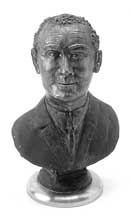 |
|
|
MARIO SALMI (1889 – 1980)
Mario Salmi was one of the greatest and best informed Art Historians of the 20th century. With his vast range of interests, he contributed in a fundamental way to scientific knowledge about the Romanesque and Renaissance period. A University teacher, Editor of art magazines, he played an important role in the management of the ‘Soprintendenze dei Beni Culturali’ in different regions of Italy, and he was officially recognized both in Italy and abroad. He held prestigious appointments, such as Vice President of the ‘Consiglio Superiore delle Antichità e Belle Arti’, President of the ‘Istituto Nazionale di Studi sul Rinascimento’ and of the ‘Commissione Nazionale Vinciana’ as well as being a member of the ‘Accademia dei Lincei’. Born in S. Giovanni Valdarno (Province of Arezzo), Salmi dearly loved Arezzo. This can be seen not only by the fact that he was President of the ‘Accademia Petrarca di Lettere e Arti’ for almost 34 years, but also by the way he dedicated his energy to the discovery of the many artistic and architectural treasures of the region, which were hitherto little appreciated. Moreover, he established the ‘Concorso Polifonico Internazionale Guido d’Arezzo’ (International Polyphonic Competition) and the ‘Biblioteca Consorziale’ (library) in the town, thanks to his tireless activity. His passion for culture led him to make courageous stands. For example, while some armoured cars were parked in front of the ‘Basilica di S. Francesco’ during the German occupation, Salmi feared that the frescos of Piero della Francesca inside the building were at risk of allied bombardment. He looked for the German Commander and discovered that he was an art historian in uniform and so he managed to convince him to have the tanks removed from the square. His volumes on the artistic heritage of the region and on the painting of Piero della Francesca are basic to the history of Arezzo.
|
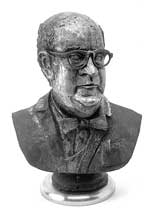 |
|
|
GAIO CILNIO MECENATE (about 70 B.C. - 8 B.C.)
This highly cultured man, of Royal Etruscan descent, was first amongst the most trusted councillors of Emperor Ottoviano Augusto. He held important political posts, particularly as an ambassador between the Sovereign and the prestigious group of intellectuals he had gathered around himself, including Virgil, Horace and Propertius. The ‘Museo Nazionale Archeologico’, which contains important remains of Etruscan and Roman art, was named after him. The great development of the ceramics industry in Arezzo during his lifetime is an indication of Mecenate’s feelings of goodwill for his home town.
|
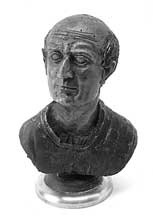 |
|
|
BEATO BENEDETTO SINIGARDI (1190 - 1282)
One of the first followers of St. Francis of Assisi, he felt his vocation after listening to a moving speech by the ‘poor man of Assisi’, who was staying in Arezzo in 1211. Benedetto, a young nobleman of Longobard descent from Arezzo, thus renounced the comforts of his original life to follow the discipline of St. Francis. He was loved and admired for his human and Christian qualities, and was nominated Minister for the Province of Le Marche by St. Francis when he was only 27 years old. Later on, he was sent to Greece, Rumania and Turkey as a missionary and, while in the Holy Land, was elected Minister for the Holy Land and the East, because of his capacity for peace and dialogue. He is thought to have built the first Franciscan Monastery in Constantinople. When he returned to Italy, he joined the ‘Convento dei Frati Minori’ in Arezzo, where his special devotion to the Virgin Mary inspired him to introduce the prayer of the ‘Angelus Domini’, the antiphon of the Incarnation, which later spread throughout the whole Catholic Church. When he died, the people of Arezzo beatified him because of the various miracles that he is said to have performed. His body lies in the Basilica di S. Francesco in this town.
|
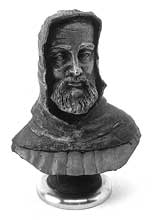 |
|
|
TOMMASO SGRICCI (1789-1836)
At No. 246 of the near by Corso Italia, lived Tommaso Sgricci. Born in Castiglion Fiorentino (Arezzo), he was a talented improviser and performer since the time when he was young. He was considered to be a real genius in the art of reciting, especially in improvising tragedies on themes proposed by the public, using original techniques of interpretation that inspired his numerous admirers in Italy, France and England. Even if his reputation was highly controversial, he was recognised by the Court and received honours from literary and scientific associations and from many towns that coined gold and silver medals for him.
|
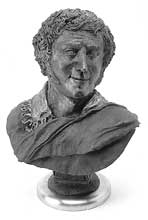 |
|
|
GIANFRANCESCO GAMURRINI (1835-1923)
The building at No. 11 of this street reminds us of the Gamurrini family. Gianfrancesco Gamurrini was one of the most important archaeologists in Italy during the second half of the 19th century and he published a fundamental study about Roman ceramics in Arezzo. He later became Director of the Archaeological Museum in Florence and in 1876 he moved to the General Management of Antiquities for the Ministry of Education. In 1880 the ‘Commissariato della Conservazione dei Monumenti della Toscana’ and of the excavations in Etruria and so he became Director of the Archaeological Map of Etruria. An academic of the Lincei, he wrote about Art History, Numismatics, Etruscan and Roman Epigraphy, Hagiography and he even delighted in poetry. For more than 50 years, he was Director of the library of the ‘Fraternità dei Laici’, which later became part of the public library in Arezzo. In 1883 he discovered there a Medieval copy of a manuscript dating back to the 4th century A. D., the “Peregrinatio Egeriae”, which was fundamental to the understanding of the ancient Christian Church, of the Holy Land and, in particular, of the Holy Sepulchre in Jerusalem.
|
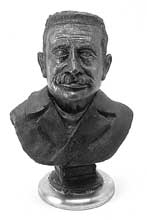 |
|
|
RISTORO D’AREZZO (about 1210 - 1290)
Very little is known about Ristoro except that he was born in Arezzo, that he was a cosmographer and literary man, author of two books, written in vernacular in 1282 in the context of the University (Studium) of Arezzo, entitled ‘Composizione del Mondo’. They are astronomical and geographical works from which knowledge about the history and physical geography of his time have been handed down. Moreover, he was deeply interested in the history of Arezzo, and he exalted the famous Coralline vases (mid 3rd century B.C.) He was also a goldsmith, designer and, as a painter, he collaborated with Margarito in making the altar-frontal of the Santuario delle Vertighe at Monte S.Savino (Arezzo).
|
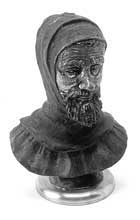 |
|
|
UBALDO PASQUI (1859-1939)
In this house with its extensive, valuable 16th century windows lived the Pasqui brothers, both of whom were self-educated and intellectuals who were nationally renowned. Angelo was a distinguished Archaeologist while Ubaldo gained fame as a Palaeographer and Historian on Medieval Arezzo, dedicating his whole life to the study of this and the artistic heritage of Arezzo as well as literary works. He published some fundamental documents and the most famous of these was, “Documents for the History of the Town of Arezzo”, written in four volumes. Another basic contribution to knowledge about local history, is the two editions of the ‘Guida di Arezzo’. The first was written in 1882, while the second with many illustrations was published in 1925, in collaboration with Ugo Viviani.
|
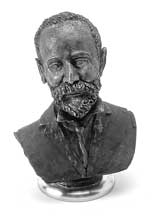 |
|
|
FRANCESCO SEVERI (1879 – 1961)
The world famous Mathematician, Francesco Severi, was born in this Via dell’Orto. He taught for a long time in the Universities of Parma, Padua and Rome, where at the age of 45, he became Rector. He was President of the National Institute of Higher Mathematics, which he founded in Rome (1938), where he held the Chair of Higher Geometry. He was a member of the National Accademy of Lincei, and academic of the ‘Pontificia Accademia delle Scienze’ and member of the Academy of France. For his fundamental contribution to the field of Algebraic Geometry, Severi can be considered the founder of a modern school of Geometry and his numerous and well-researched writings make an invaluable contribution to the field of Mathematics, in Italy and the rest of the world.
|
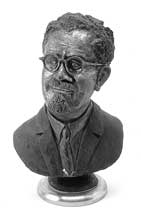 |
|
|
FRANCESCO REDI (1626-1697)
Francesco Redi , a distinguished scientist and writer with broad cultural interests, studied Medicine and Philosophy. In Florence, he was nominated Court Physician to the Grand Duke Ferdinando II and to Cosimo III and he carried out practical and scientific experiments in the ‘Accademia del Cimento’. An astute observer, Redi also applied experimental methods to Medecine. He wrote about optics and he ventured into complicated problems of Biology, disproving the ancient theory about the spontaneous procreation of insects. He carried out thorough research into parasites and sake poison. As a literary figure, he was ‘Arciconsole’ of the ‘Accademia della Crusca’, an associate of the ‘Accademia dell’Arcadia’ and a forerunner of modern literary studies and of the study of dialects. He also helped to compile the 3rd edition of the ‘Vocabolario della Crusca’ (1691). But his most lively genius can be seen in the famous ‘Bacco in Toscana’, a brilliant and ironical collection of 980 verses in praise of wine. He was closely linked to the Jesuits and to the library of their school in Arezzo, to which he donated many books. His sepulchral monument , which was made by the great Florentine sculptor, Giovanbattista Foggini in collaboration with Ferdinando Vacca from Carrara, is now in Arezzo Cathedral.
|
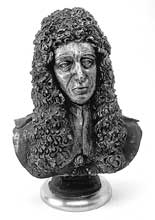 |
|
|
SANTA TERESA MARGHERITA REDI
The young Carmelite nun, S. Teresa Margherita of the ‘Cuore del Gesù, who died at only 23 years of age, was born here on 15th July, 1747, into the aristocratic Redi family. She was the second of thirteen children and sister of Francesco Saverio, her little brother who became a Jesuit priest. She said ‘Goodbye’ to him for the last time before entering the Convent with the words “ Cecchino, do you love God? …love Jesus; if only you knew how beautiful, how dear, how lovable he is! “ Anna Maria (this was the name she was baptized with before she became a nun) professed her total faith in this way. She devoted her short life to intense contemplation, and was an outstanding example of humility and Christian charity in the cloisters of the Monastery of the Barefooted Carmelites of S. Teresa in Florence.
|
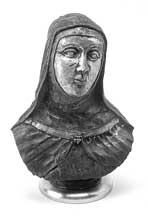 |
|
|
PIETRO BENVENUTI (1769-1844)
One of the most important exponents of Neoclassical art in Italy, the famous painter of historical, mythological and religious scenes was also Director of Fine Arts in Florence. He did a great painting in the Chapel of the ‘Madonna del Conforto’ in Arezzo Cathedral(1804), depicting Judith, who is showing the head of Holofernes to the people. It is considered to be a real masterpiece and his great friend, the famous sculptor, Antonio Canova (1757-1822), came to Arezzo especially to admire it. Among his best known and most beautiful frescoes are the ones in Florence, in the room of Hercules in ‘Palazzo Pitti’ and inside the dome of the ‘Cappella dei Principi’.
|
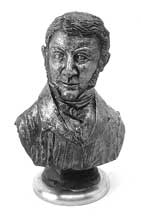 |
|
|
VITTORIO FOSSOMBRONI (1754-1844)
An outstanding personality, Vittorio was born in Arezzo into the noble family, Fossombroni, that was originally from Fossombrone, a town in the Province of Pesaro-Urbino, and moved to Arezzo in the 1400’s. Mathematician, economist and engineer specialising in hydraulics, he was a teacher at the University of Pisa.
He became famous for his writings on irrigation and he projected and supervised the work to drain the Valdichiana. A first-class intellectual and politician, he was called to Paris during the Napoleonic Empire, nominated as Senator, decorated by the Legion of Honour and given the title of Count. After the Restoration he helped the Grand Duke Ferdinand III to govern Lorraine and rose to great political heights in the government as Prime Minister and Minister of Foreign Affairs.
|
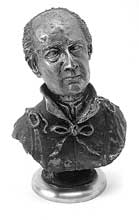 |
|
|
GUIDO D’AREZZO (11th century)
The date and place of birth of Guido d’Arezzo are not certain. Perhaps he was born in Talla in the Province of Arezzo around the year 1000 and he was certainly a Benedictine monk in the Abbey of Pomposa, near to Ferrara. Called to the Pionta on the hill of the ‘Duomo Vecchio’ (Old Cathedral) in Arezzo by the Bishop Teodaldo in 1025, he set about his musical reform with the intention of facilitating prayer through song. In order to name his notes, he used syllables taken from the anthem to St. John the Baptist by Paolo di Warnerfrido (known as Paolo Diacono). “UT (replaced by DO) queant laxis Resonare fibris / Mira gestorum Famuli tuorum / SOLve polluti labii reatum / Sancte Jhoannes” (So that the faithful on the lento lyre / can sing about your great deeds / free impure lips from guilt / St. John). Through the Bishop Teodaldo, he was received by Pope Giovanni XIX between 1030 and 1032 and he approved of the brilliant idea of singing melodies according to a method, without having to learn the rhythms and intonations by heart. Guido later left Arezzo and died in Camaldoli, probably before he was very old.
|
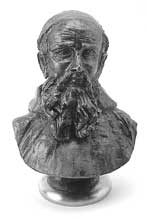 |
|
|
GUITTONE D’AREZZO (about 1230 - 1294)
He is the poet who best represents the transition between Sicilian poetry of Provençal influence and Stilnovo, which was initiated by Guido Guinizelli. Leader of the literary movement belonging to the generation that preceded Dante Alighieri, he was one of the first Italian writers to use vernacular in literary exprimentation and poetic research. In the ‘Lettere’, which was his most exacting composition, his strong sense of moral and civil duty stands out. Guittone was born in S. Firmina near Arezzo and, son of Viva di Michele, he belonged to the military and religious order of the ‘Cavalieri di Santa Maria’ (known as ‘Gaudenti monks’), founded in Langdoc in Southern France in 1208.
|
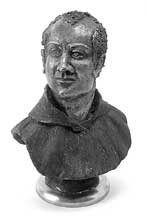 |
|
|
MARGARITO D’AREZZO (13th century)
Known as Margaritone, which was the name given to him by Vasari in the ‘Vite’, the dates concerning his life are uncertain, except for the year 1262, when a notary document that proves that he was in Arezzo was signed. Margarito was the earliest known painter in Arezzo and only recently has he been estimated and acknowledged as one of the most significant figures in Italy in the 13th century because of his exceptional sensitivity and artistic talent. Among his most important works are a painted Cross called the ‘Madonna col Bambino in trono’, and ‘S. Francesco’, which is the most famous painting of the ‘Poor Man of Assisi’. It it is displayed at the ‘Museo Statale d’Arte Medievale e Moderna’ in Arezzo. Because it was held to be his true image, at the time this painting was used as a model for many copies and reproductions. ‘La Madonna Kress’, which is now in Washington, and the Altar painting of the Madonna and Child, which is displayed at the National Gallery in London, are two of Margaritone’s earliest works.
Another of his valuable paintings is the Altar Frontal in the Santuario delle Vertighe at Monte S. Savino in the Province of Arezzo.
|
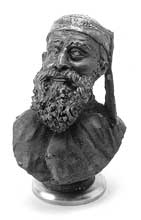 |
|
|
FRANCIS PETRARCH ( 1304-1374 )
The first modern lyric poet, the great Francesco Petrarca was born in this house on 20th July, 1304. His father, Ser Petracco, a friend of Dante Alighieri, had been exiled from Florence and found himself in Arezzo. Petrarca spent his life in various cities, frequently moving around Italy and Europe, often with important missions and responsibilities in the Courts of Lords and Cardinals. The meeting at Avignon in 1327 with Laura, the female symbol of love poetry was to inspire the “Canzoniere”, which was the most important collection of compositions in vernacular by the cultured Humanist. He later became a model for other poets and on 8th April, 1341 he was crowned ‘great poet and historian’ at Campidoglio in Rome. He withdrew to Arqua in the Province of Padua in 1369, where he died while studying in his own library. Arezzo has honoured him not only with a monument in the ‘Prato’, but also by naming after him the ‘Accademia di Lettere, Arti e Scienze’,which can be found in this building. This is one of the most prestigious institutions in the town. The ‘Liceo Classico’ (by Royal Decree of 4th March 1865 ) was also named after him.
|
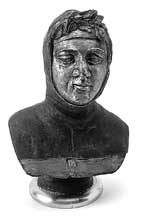 |
|
|
SPINELLO ARETINO (1350 - 1411)
He is the best known local artist of the 14th century, even though his most significant work was carried out in Florence, Pisa and Siena. He produced works of fundamental importance in this town, particularly in the Chuches of S. Domenico, the SS. Annunziata, and the Basilica of S. Francesco, where he painted the valuable frescoes of the ‘Annunciation’ and of the ‘Cappella Guasconi’. Another outstanding painting is the ‘Pietà’, made for the lunette of the building of the ‘Fraternità dei Laici’ in Piazza Grande, which can now be found in the ‘Museo d’Arte Medievale e Moderno’ in Arezzo. Parri (1387-1453), the son of Spinello Aretino, was also a talented painter. He was a highly original artist and he differentiated his style from that of his father, working instead in European Gothic style. He had contacts both in the circle of Lorenzo Ghiberti and with Sienese painters of the 1400’s.
|
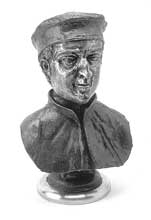 |
|
|
LEONARDO BRUNI ( 1369 – 1444)
This impressive building, which today accommodates the ‘Museo Statale d’Arte Medievale e Moderna’, was constructed by the Bruni family, Leonardo being the most important member. A Humanist and Politician, he became Secretary to the Pope in Rome and in 1410 Chancellor of the Florentine Republic for which he received wide acclaim. His monumental tomb in the Church of S. Croce in Florence was designed in his honour by the sculptor, Bernardo Rossellino (1409 –1464). His lively historical and literary genius could be identified in his various works in vernacular but it excelled in the translation of Latin and Greek. He wrote the “Historiae” in Latin and, because of his rigorous use of historical documents, it became the first true history of Florence from its origins until 1404. It was translated into Italian by Donato Acciaiuoli (1429 – 1478) and was widely circulated during the Renaissance period.
|
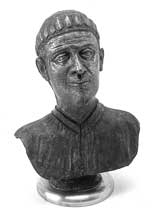 |
|
|
PIERO DELLA FRANCESCA (about 1415 - 1492)
He is one of the greatest Renaissance painters after the generation of Masaccio and Beato Angelico. A Mathematician and Theorist on perspective, highly original and even influenced by Flemish painting, Piero saw art as an universal value in which geometrical forms, light, shape and colour could be identified. His artistic work was done in Florence, Borgo Sansepolcro, which was his birth-place, Rimini, Ferrara, Rome and Arezzo but mainly in Urbino at the court of Federico da Montefeltro, whose portrait of himself and that of his wife, Battista Sforza, are famous. His major work, which is a real master-piece, is the series of frescoes depicting the Legend of the True Cross in the choir of the Basilica of S. Francesco in this town. Many other of Piero’s paintings are admired, among which, the ‘Madonna della Misericordia’ and the ‘Resurrezione’ at S. Sepolcro, ‘La Madonna del Parto, at Monterchi, and the ‘Flagellazione di Cristo’ in Urbino. Some of his most outstanding works can be found in Boston, at the Louvre and at the National Gallery in London.
|
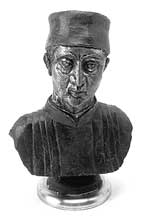 |
|
|
MICHELANGELO BUONARROTI (1474-1564)
Born in Caprese Michelangelo (Provincia di Arezzo), the brilliant Renaissance artist was grateful to his native land for his gift of creativity and he wrote to his friend, Giorgio Vasari, “ If I have any genius, it is the result of being born in the fine air of your town, Arezzo.”
The incomparable architect, sculptor and painter is known all over the world for his numerous masterpieces. If we only mention the best known of these, from his enthusiastic activity in Rome we can note the sculpture of the ‘Pietà’ in St. Peter’s, the frescos in the Sistine Chapel, the tomb of Julius II with the famous statue of Moses, the design of St. Peter’s in the Vatican, with its famous dome. In Florence he produced the statue of David, the new Sacresty of S. Lorenzo, with the tombs of the Medici family. In September 1529 Michelangelo was expected in Arezzo to plan improvements to the Town fortifications. However, it is not certain from the documents if he ever carried out this task.
|
 |
|
|
|
|
Copyright © 2008 ArezzoTurismo p.i. 01756610513
|
|
|

